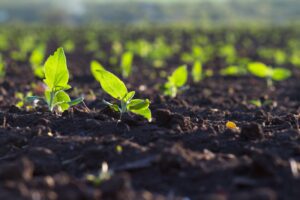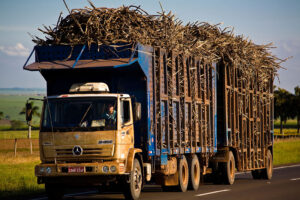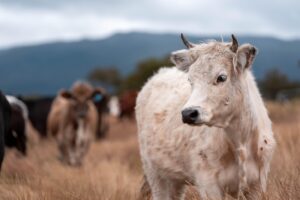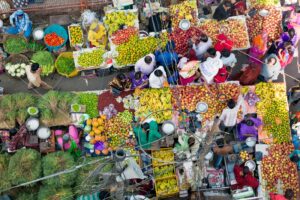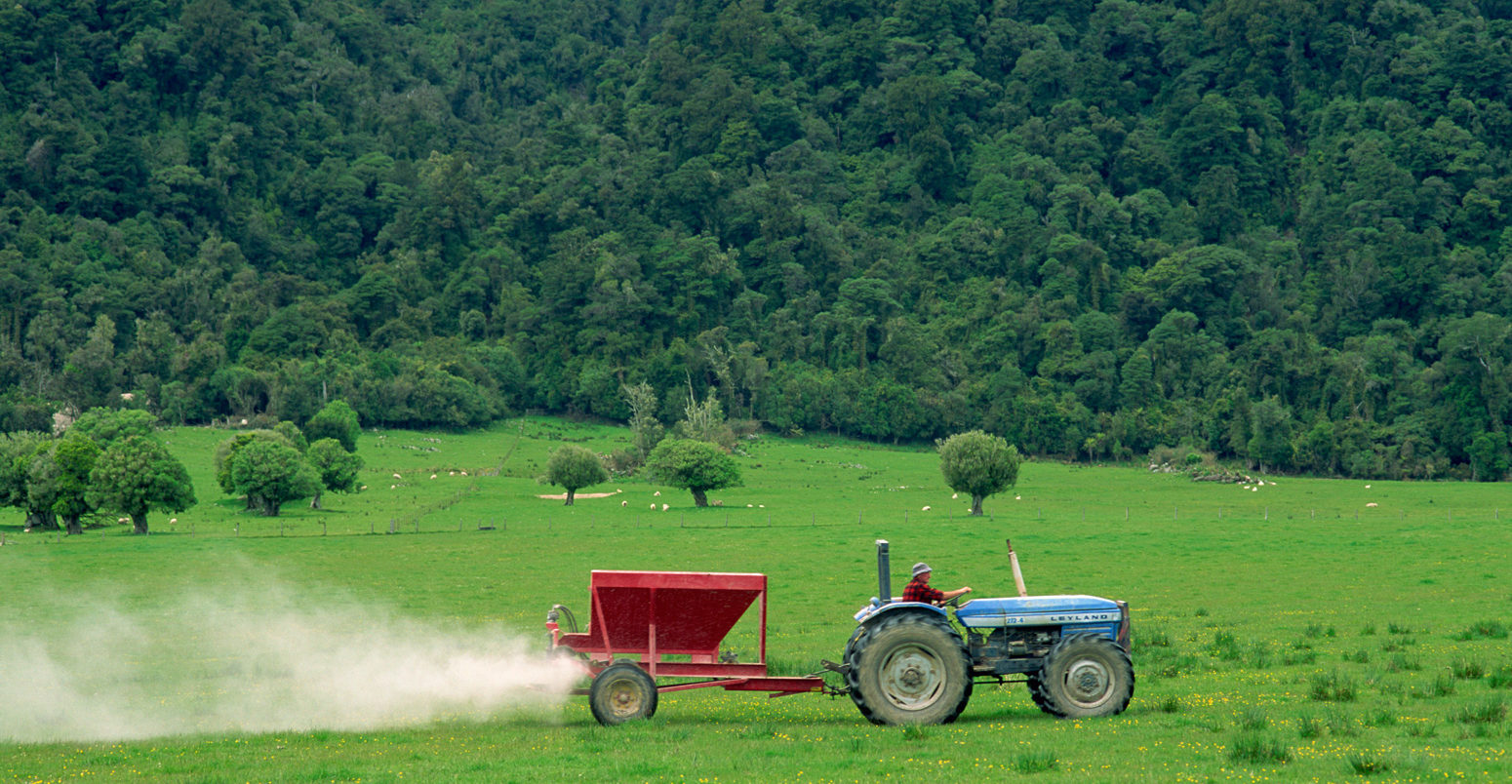
Q&A: What does the world’s reliance on fertilisers mean for climate change?
Giuliana Viglione
07.11.22Giuliana Viglione
11.07.2022 | 8:00amThe invention of nitrogen fertilisers has been called “the most important invention of the 20th century”. The extra nutrients added to crops has allowed the world’s population to boom – from 1.6 billion people in 1900 to nearly 7.8 billion today.
But while fertilisers have allowed food production to expand around the globe, the intensification of agriculture has come at a cost – to the environment, climate and health of humans, animals and soil alike, scientists tell Carbon Brief.
The global production of fertilisers is responsible for around 1.4% of annual CO2 emissions, and fertiliser use is a major contributor of non-CO2 greenhouse gas emissions.
Now, scientists and farmers are faced with a new dilemma: how to feed a still-growing population while reducing agriculture’s impact on climate and the environment.
Some are trying to end their fertiliser use altogether, while others are looking at how to reduce the amount of nutrients lost by optimising fertiliser application and management. And others are trying to recover lost nutrients from waste, where they can be recycled back into the farm.
While the issue of agricultural emissions has started to make its way into international climate negotiations, there is still a long way to go, one scientist tells Carbon Brief. But Russia’s invasion of Ukraine earlier this year – and the subsequent spikes in fertiliser prices – leave many researchers optimistic that change is on the horizon.
In this article, Carbon Brief explores the history of fertiliser use, the climate costs of agricultural industrialisation, and how the world can reduce its overreliance on synthetic, fossil fuel-based fertilisers.
- How is fertiliser used around the world?
- How did synthetic fertiliser change the world?
- How is synthetic fertiliser produced?
- What are the climate impacts of fertiliser?
- How do organic fertilisers compare to synthetic ones?
- How did Russia’s invasion of Ukraine affect the fertiliser market?
- What are governments doing to regulate fertiliser use?
- How can farming practices reduce fertiliser dependency?
- How can the world reduce fertiliser waste?
How is fertiliser used around the world?
Beyond CO2 and water, a plant needs three primary nutrients in large quantities in order to grow: nitrogen, phosphorus and potassium. These nutrients, which are sucked up from the soil by a plant’s root system, have several different roles to play.
Among other things, nitrogen is a major component of chlorophyll, which is needed for photosynthesis, and amino acids, which are crucial for plant development. Phosphorus is heavily involved in the way plants produce energy. Potassium plays a key role in regulating how a plant transports and uses water.
Although nitrogen is the most abundant element on Earth, it is primarily found as “unreactive” nitrogen gas in the atmosphere. Its inert nature means that plants are unable to incorporate this nitrogen into their cells. Rather, plants need a reactive, or “biologically available”, form of the element in order to build new biomass.
In the absence of human intervention, plants maintain a careful balance of nutrients in the soil. Certain microbes live symbiotically with legumes and other plants, taking nitrogen gas from the air and “fixing” it into the forms that plants can use, such as ammonia. The diagram below shows the processes that transform nitrogen into different forms in the soil.
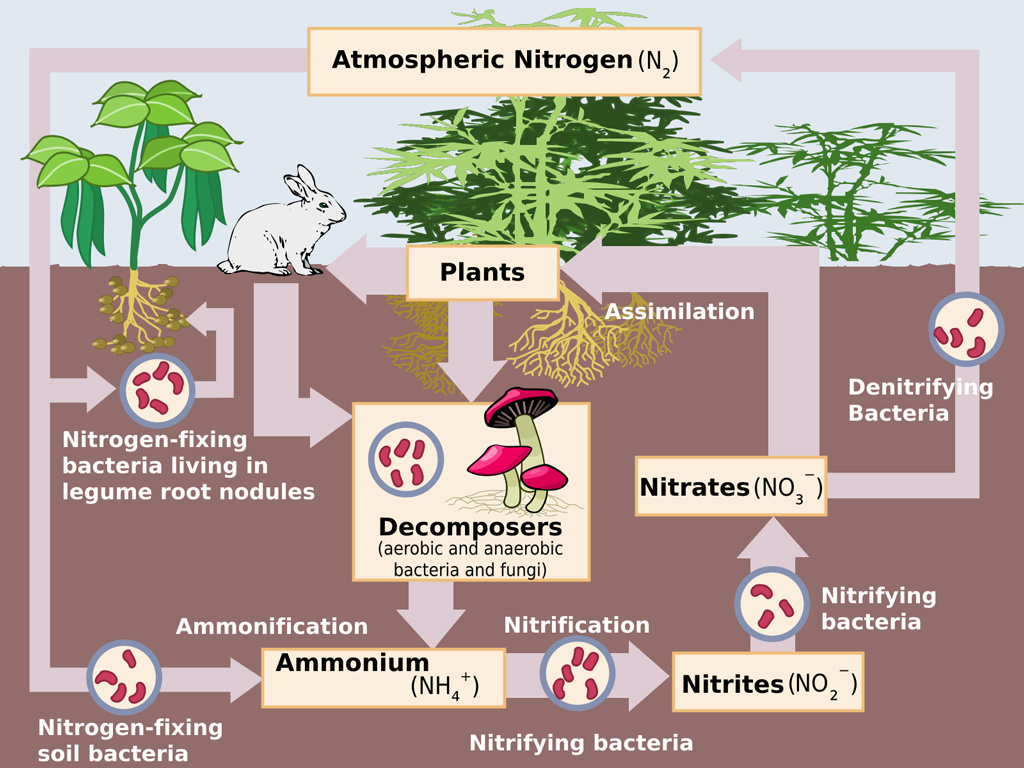
While each of these three major nutrients is naturally found in soils, for thousands of years, humans have been adding more in the form of fertilisers to encourage plant growth and boost crop yields.
Fertilisers can broadly be separated into two categories: organic fertilisers and mineral fertilisers, sometimes referred to as chemical or synthetic fertilisers. Together, nitrogen, phosphorus and potassium fertilisers are known as “NPK fertilisers”.
Of the “eight major fertilisers” as classified by DTN, a US-based data and analytics company, three contain a mixture of nitrogen and phosphorus, four are nitrogen-only and the remaining one is a potassium-containing product.
Today, the world applies more than 100m tonnes of synthetic nitrogen fertiliser to its crops every year, according to data (pdf) from the UN Food and Agriculture Organization (FAO). Around half of this is used to boost the production of cereals – predominantly maize, wheat and rice. In addition, around 50m tonnes of phosphorus fertilisers and more than 40m tonnes of potassium are used annually.
Six companies have market caps in the tens of billions of US dollars: Canada’s Nutrien, Australia’s Wesfarmers, US-based CF Industries, SABIC Agri-Nutrients Company (formerly the Saudi Arabian Fertilizer Company), the US-based Mosaic Company and the ICL Group, formerly Israel Chemicals Ltd.
As the map below illustrates, synthetic fertiliser use is high in the US, Canada and western Europe, where large-scale, mechanised agriculture is the norm. Its use is also high in several large, fast-growing economies, including Brazil, China and India. By contrast, fertiliser use is low across most of Africa, with Egypt being a notable exception.
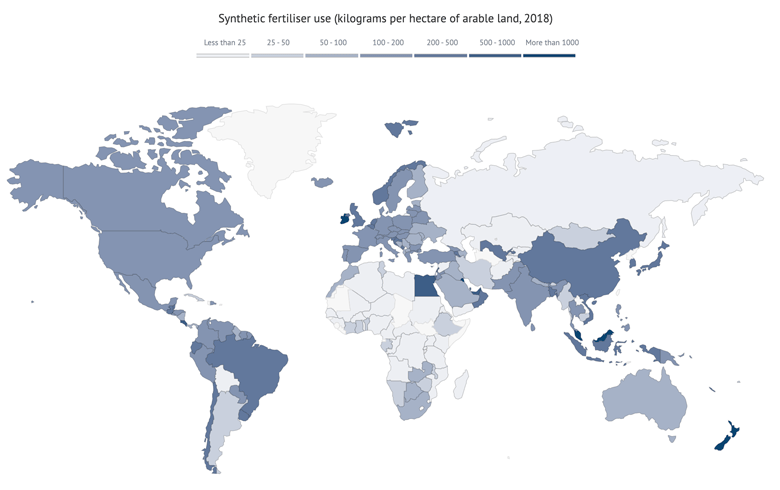
This use varies widely around the world, depending on the types of crops grown, the soil quality and myriad other factors. Nearly half of fertiliser applied in the US is used on maize fields, while soya crops are responsible for 40% of Brazil’s fertiliser consumption, according to a 2017 report (pdf) from the International Fertilizer Association and the International Plant Nutrition Institute.
Fertiliser use is even more highly skewed in some other countries. For example, 83% of fertiliser used in Malaysia is applied to oil palm plantations, while just under 90% of New Zealand fertiliser use is for grasslands. These regional differences extend to the types of fertiliser applied as well. Since soya, as with other legumes, is capable of fixing its own nitrogen, these plantations require higher inputs of phosphorus and lower use of nitrogen fertiliser.
How did synthetic fertiliser change the world?
On an industrial scale, nitrogen fertiliser is made using a chemical reaction known as the Haber-Bosch process. Initially developed in the early part of the 20th century, the reaction burns fossil gas to produce hydrogen gas. The process then takes this hydrogen and nitrogen from the air and crushes them together at high temperature and pressure to make ammonia, as shown in the diagram below.

Both Fritz Haber and Carl Bosch won the Nobel Prize in chemistry (in 1918 and 1931, respectively) in recognition of their work developing the process and other high-pressure chemical reactions. However, it was not until the aftermath of the second world war that fertiliser use began to skyrocket around the world. Since 1960, the amount of fertiliser used annually has increased nearly 10-fold, according to the Intergovernmental Panel on Climate Change’s (IPCC) 2019 special report on climate change and land.
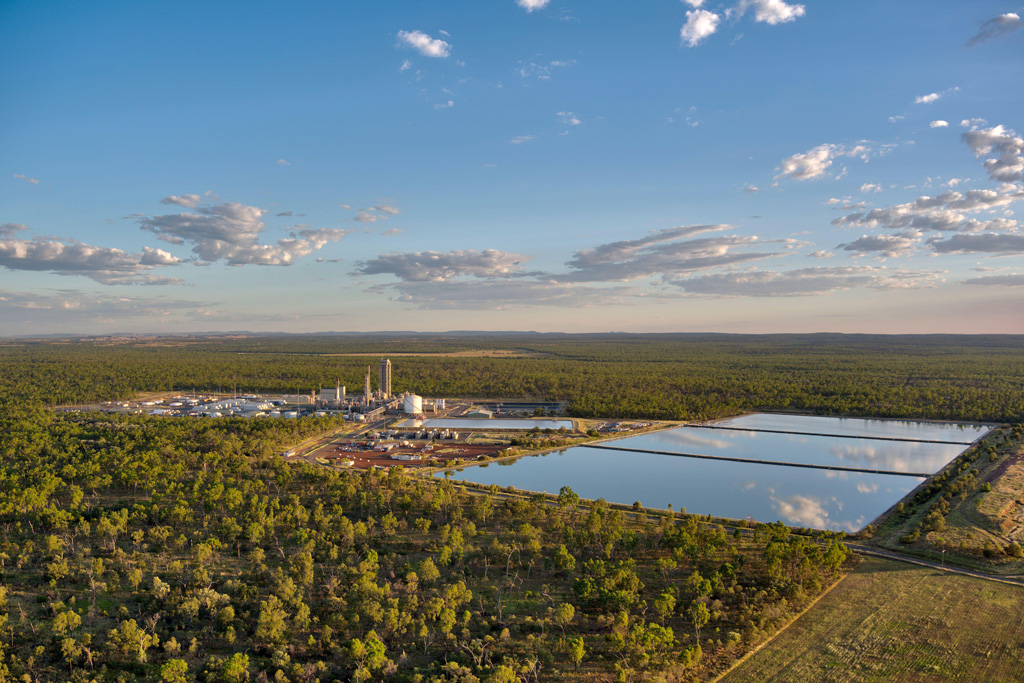
These increases in fertiliser usage have gone hand-in-hand with increasing food yields – global cereal production has grown three- or four-fold in that same period.
“All of the increased food demand for a growing population was possible because of this invention,” says Dr JK Ladha, an agronomist and soil microbiologist at the University of California, Davis.
The chart below shows how the world’s population and fertiliser use have grown concurrently since the end of the second world war.
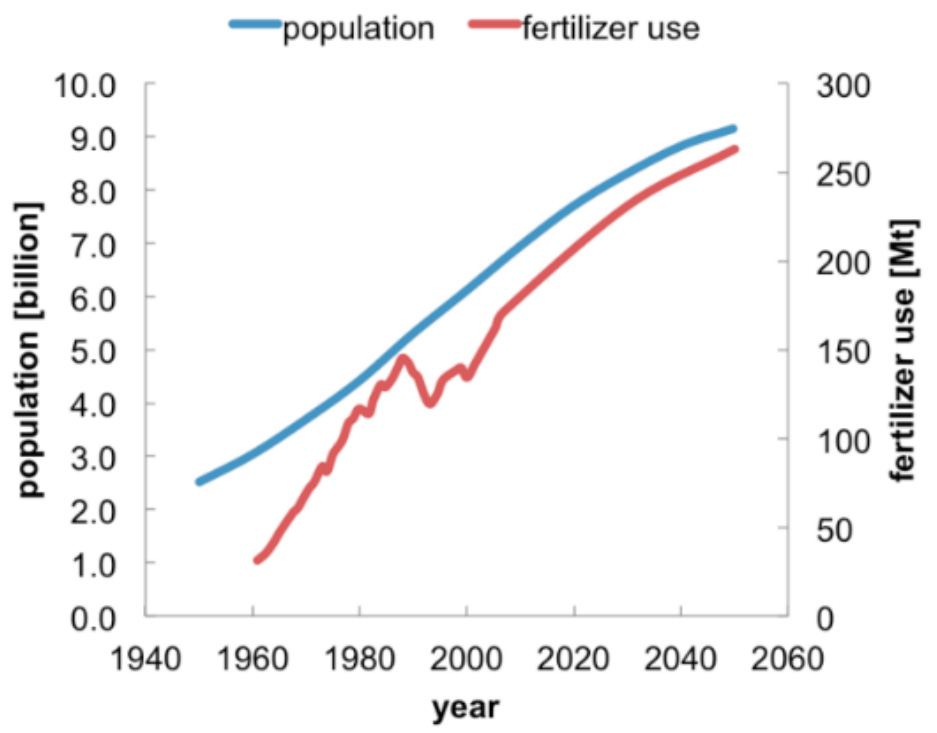
One oft-cited statistic estimates that nitrogen fertilisers are responsible for feeding half of the world’s population. However, that number is “really ropey”, says Prof Mark Sutton, an environmental scientist at the UK Centre for Ecology and Hydrology, who was one of the authors of the paper where the figure originated.
He explains that the number is based on current diets, which have themselves been enabled by the widespread use of fertiliser. “Had we not been eating high-meat diets, the world could have clearly fed more people with less fertiliser,” Sutton tells Carbon Brief:
“We wouldn’t have all those livestock emissions if we hadn’t had enough nitrogen to feed all those animals to increase our population.”
This rapid expansion of synthetic fertiliser use coincided with the Green Revolution, a large-scale push to increase agricultural production around the world in the 1960s, especially in the global south. The Green Revolution is associated with the development of new crop varieties – genetically modified to produce higher yields – and the increased use of agrochemicals, irrigation and mechanisation. But all of that increased productivity was only made possible by upscaling fertiliser production, Sutton says:
“[Genetic engineering] was the engine of the Green Revolution – the high-yielding genetic varieties – but the fuel of the Green Revolution, to power the engine, was the fertilisers.”
How is synthetic fertiliser produced?
The mass adoption of synthetic fertilisers has come at a significant cost to the environment. Because the Haber-Bosch process is carried out at high temperature and pressure, the greenhouse gas emissions associated with it are substantial.
In fact, producing ammonia fertilisers is responsible for about 1% of all global energy use and 1.4% of CO2 emissions – almost equivalent to the emissions of Germany. About 40% of the fossil gas input into the process is burned to fuel the reaction, with the remaining 60% being used as the feedstock.
By 1970, scientists were sounding the alarm about the sustainability of the Green Revolution. An article published in the journal BioScience that year asked, “how green is the Green Revolution?”, while a paper published in the American Journal of Agricultural Economics that same year laid out the “generations of problems” that the technological revolution had introduced.
Unlike nitrogen, phosphorus and potassium are found in limited quantities within the Earth itself. Because of this, they pose their own unique challenges – and their own threats to the environment.
Phosphorus ore, or phosphate rock, is mined and then treated with sulphuric acid to produce phosphoric acid, which can be transformed into a slew of different phosphate fertilisers.
As the map below highlights, the world’s phosphorus deposits are highly concentrated, with around 85% of the global supply found in just five countries – and 70% of the total reserves found across Morocco and Western Sahara. Other major producing countries are China, the US and Russia.
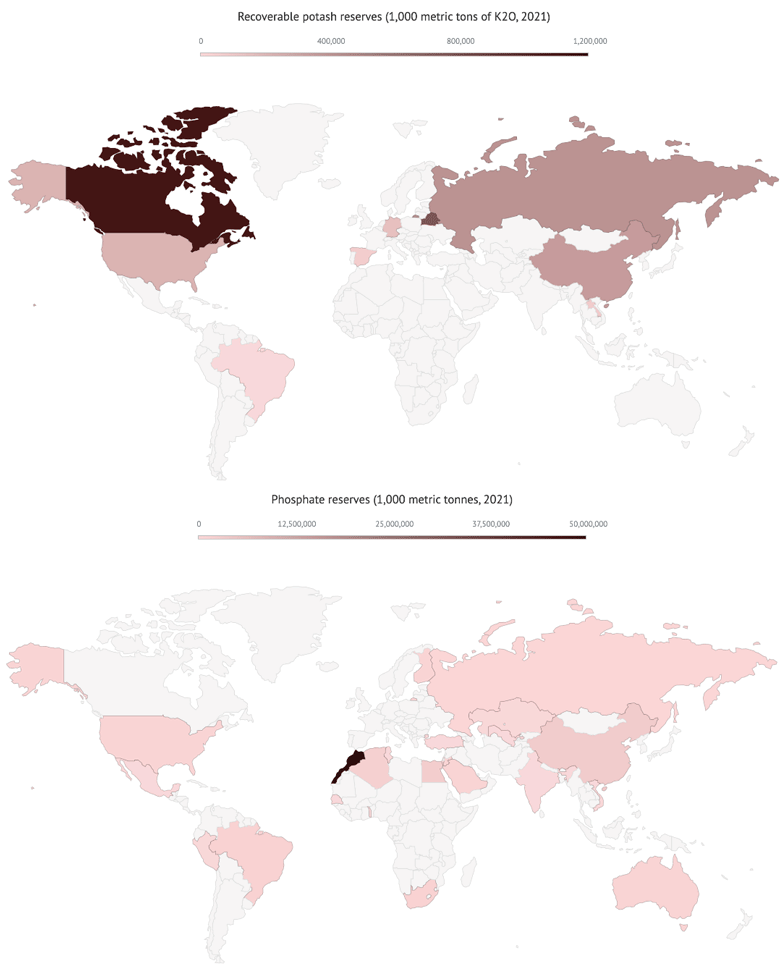
This concentration of reserves and production leaves much of the world vulnerable to disruption and other market forces. For example, during the 2008 global financial crisis, prices of phosphorus rock soared 800%. Similar price spikes have been observed since the Russian invasion of Ukraine in February 2022.
As with many extractable resources, the highest-quality reserves of phosphorus are often the first to be depleted. As the purer deposits are used up, more rock has to be mined to get the same quantity of usable phosphorus. These less-pure deposits also require more intensive processing to remove harmful impurities, such as cadmium, arsenic and lead. If not properly processed, these contaminants can end up being spread on fields and taken up by plants.
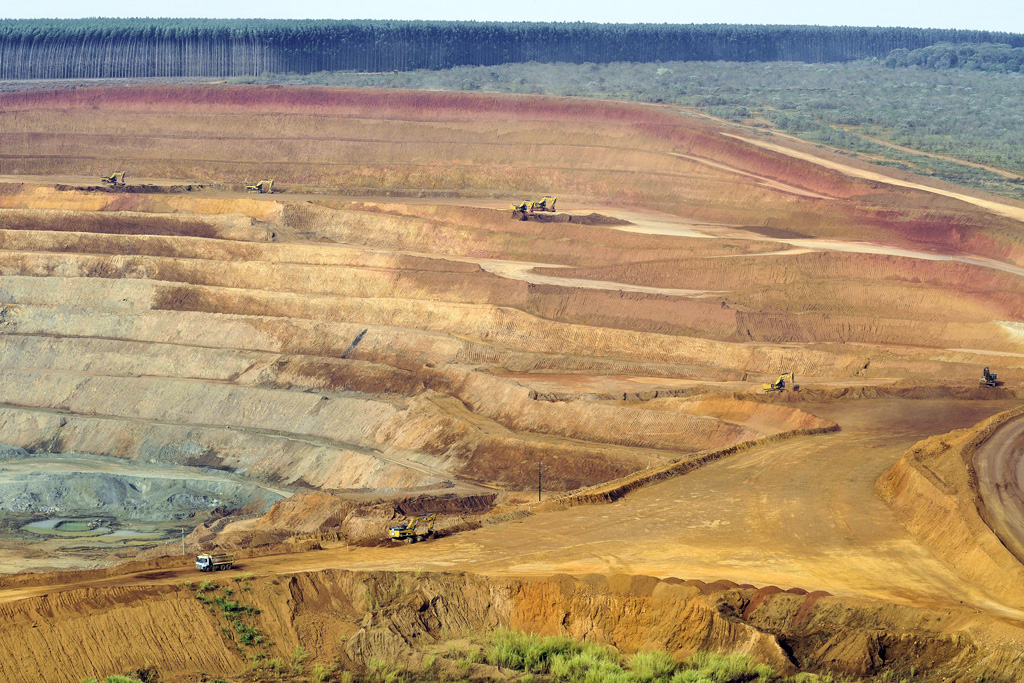
Although discussions around the environmental impacts of fertilisers tend to focus on nitrogen, the limited quantity of phosphorus in the Earth means that that resource is actually a more pressing concern, says Dr Céline Vaneeckhaute, an environmental engineer at Laval University in Quebec. “It’s really depleting at a rapid pace,” she tells Carbon Brief.
Furthermore, the geopolitical tensions surrounding its largest suppliers mean that the fertiliser industry is loathe to talk about phosphorus, Sutton says. “The moment we start talking about phosphorus, the industry gets very jittery,” he notes:
“At the heart of that is this difficulty about land resources, in particular Western Sahara…The fertiliser industry doesn’t want to talk about that.”
Western Sahara is a disputed territory, partly administered by Morocco and partly by the Sahrawi Arab Democratic Republic, which represents the Indigenous Sahrawi people of the region. The Sahrawis have accused Morocco of illegally mining and exporting phosphate in Sahrawi-controlled portions of the territory. As a result of this conflict, while engagement around nitrogen has been building, phosphorus is at “a slower speed”, Sutton says.
Potassium, or potash, is also generally mined from deposits. A variety of chemical processes can be used to turn the ore into a usable fertiliser. While potash deposits are not quite as geographically concentrated as those of phosphorus, they are still predominantly found in a select few countries, as shown in the map below.
Canada and Belarus together contain nearly half of the world’s potash reserves; adding Russia, China, the US and Germany accounts for 85% of the total, as seen in the map above. As with phosphorus, Russia’s invasion of Ukraine sent potash prices soaring on the global market.
In addition to the energy-intensive extractive processes needed to remove these minerals from the ground, the global trade of these highly localised nutrients disrupts the Earth’s natural nutrient cycling, says Prof Amanda Posselt Martins, a soil scientist at the Federal University of Rio Grande do Sul in Brazil. She tells Carbon Brief:
“The global cycle of nutrients is completely unbalanced. This is terrible concerning sustainability – social sustainability, economic sustainability and especially environmental sustainability.”
What are the climate impacts of fertiliser?
Fertiliser contributes to climate change in several key ways. Energy-intensive extractive and manufacturing processes require the burning of significant amounts of fossil fuels to turn raw materials into usable fertilisers.
Many types of fertiliser are transported across long distances, adding to their greenhouse footprints. As with food-related emissions, transportation makes up only a small fraction of fertilisers' greenhouse gas emissions – just a few percent of the total, according to Vaneeckhaute.
However, recent research has suggested that the transport emissions associated with the entire food system – including transporting fertilisers, machinery and animal feed – are significantly higher than previously estimated.
When nitrogen-containing fertilisers are applied to a field, some of the reactive nitrogen is taken up by plants, but another portion is lost to the environment. This is leached out into the soils, washed into rivers and other bodies of water by rain or irrigation water or released from the field directly into the atmosphere as vapour. Nutrient runoff can feed algal blooms, releasing methane and leading to oxygen declines in watercourses that can kill fish.
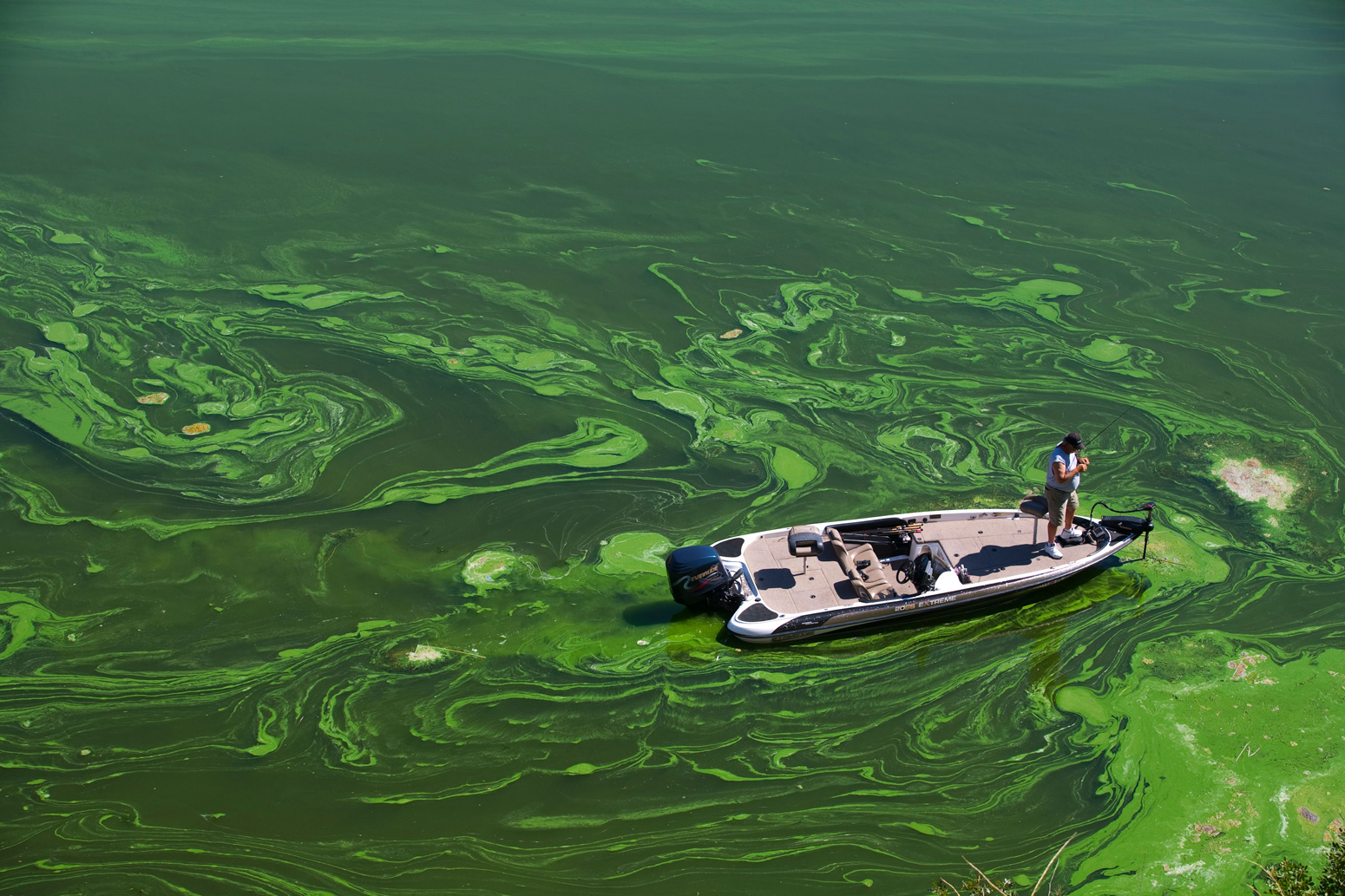
A third portion is lost to the atmosphere as nitrous oxide, a greenhouse gas nearly 300 times as powerful as CO2. Microbes in the soil can break down the nitrogen fertilisers applied to a field to produce nitrous oxide. Nitrous oxide is the third-most abundant greenhouse gas in the atmosphere, after CO2 and methane. Emissions of the gas are predominantly due to agriculture. In 2019, nitrous oxide emissions were about one-third higher than they were in 1990. (For more on nitrous oxide emissions, see Carbon Brief’s coverage of a 2020 Nature study that quantified global sources and sinks of the gas.)
The IPCC’s sixth assessment report on mitigation stated with high confidence that rising nitrous oxide emissions are “dominated by agriculture, notably from manure application, nitrogen deposition and nitrogen fertiliser use”. It added:
“Improved crop nutrient management can reduce nitrous oxide emissions from cropland soils.”
However, the full picture of the nitrogen cycle and its role in climate is not quite so simple. Nitrogen applied to crops can also escape to the atmosphere as ammonia or NOx gases, which can form particulate matter, absorbing or reflecting sunlight and producing a cooling effect. The warming and cooling effects of nitrogen approximately cancel each other out – for now, Sutton says:
“The short-term effects are net cooling, but the very long-term effect is a commitment to net warming…It’s clear that we need to do much more in managing nitrogen.”
This particulate matter is also a major contributor to air pollution – a 2016 study found that in many places, agriculture-related aerosols “dominate over the combined contributions from all other anthropogenic pollution”.
Fertiliser use is not the only climate consideration. The nutrient utilisation efficiency of a fertiliser depends on the agronomic conditions under which it is applied, Ladha explains. So changing rainfall patterns in the future can affect how effective fertilisers can be, he says:
“The water problem is going to get worse; it is already getting worse. For example, there are many areas in Asia where farmers were growing three crops of rice, then they came down to two, and those who are growing two crops of rice, only a single crop is growing. The water is just not there.”
Furthermore, an overuse of fertilisers can decimate microbial communities in the soil and decrease soil health. And excess phosphorus in the soil can become fixed to organic material or salts, resulting in a form of phosphate that is unusable by plants. This becomes a problem for farmers, says Vaneeckhaute, because plants are able to take up less and less of the applied phosphorus – often resulting in farmers over-fertilising to compensate. And as the mineral builds up in the soils, the amount of phosphorus lost to the environment can increase.
“Nowadays I see that fertilisers are helping to degrade [the soil] and not build fertile soils,” Martins says:
“Here in Brazil, we focus too much on putting nutrients [in]…This is the main problem of our soils. Many of our soils are already full of nutrients.”
She adds that the situation in Brazil is following a familiar pattern:
“Everything that we saw in Europe [and the] US some years ago, in terms of environmental problems, we are seeing here in Brazil due to the bad management of soils and fertilisers.”
How do organic fertilisers compare to synthetic ones?
Of course, long before the development of the Haber-Bosch process, humans fertilised their crops using different methods. A 2013 study provides evidence that Neolithic farmers used manure from livestock to enhance the yields of key crops.
Organic fertilisers are predominantly composed of crop residues or animal waste or remains. Today, the most commonly used organic fertilisers around the world include manures, compost and bone meal. The specific nutrient ratio of a given fertiliser depends on its source. Manures are rich in all three primary nutrients, while bone meal fertilisers contain high levels of phosphorus. Guano – bird or bat droppings used as fertiliser – is especially rich in nitrogen.
Guano – which comprises nearly pure nitrogen, phosphorus and potassium – was once the world’s favourite fertiliser. Used for centuries by the Inca, the substance was brought to Europe in the early 1800s, where it quickly became a hot commodity. The burgeoning guano industry shipped millions of tonnes of the droppings across the sea from Peru, stripping down the deposits faster than they could be replenished. Eventually, with islands flattened and reserves depleted, the guano market crashed. Although it is still used today in some countries, particularly in Asia, the age of guano was largely ended by the advent of the Haber-Bosch process.
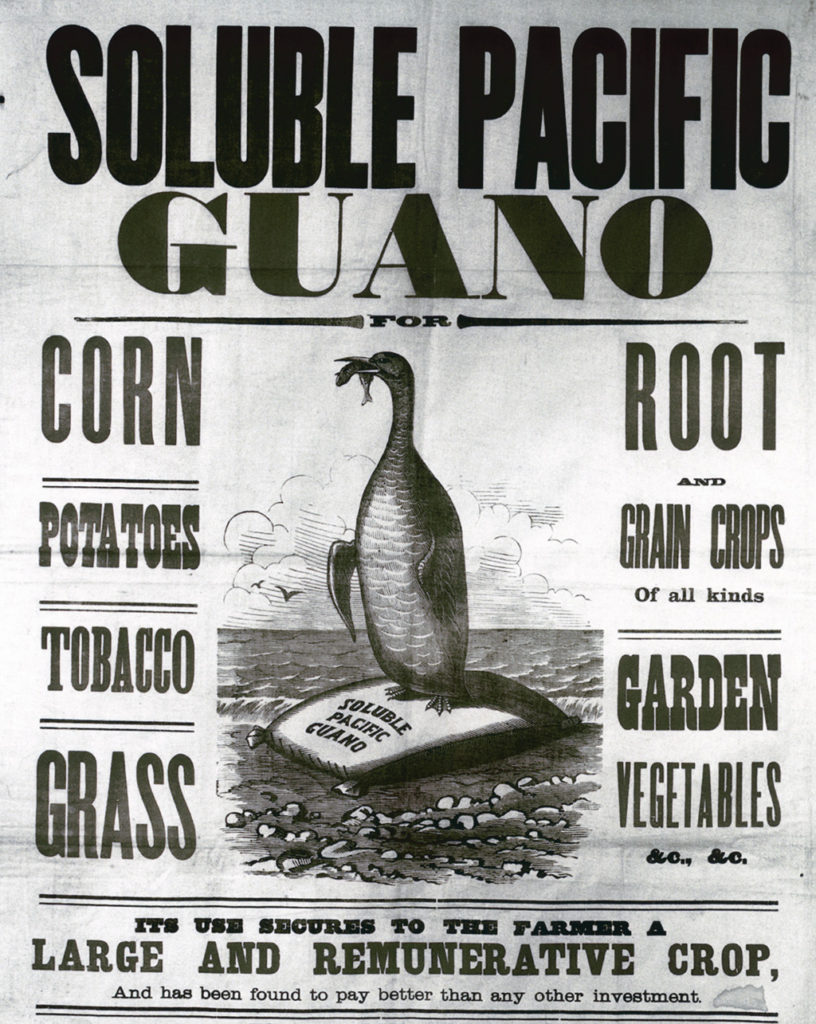
The collapse following the guano “gold rush” should act as a warning about the world’s current dependence on phosphorus and potassium fertilisers, Sutton says. The same issues will ultimately apply to the non-renewable mineral fertilisers the world currently relies on, he warns:
“It might look far off, but I don’t think there’s any reason for complacency.”
Over recent decades, several countries have attempted to make the move away from synthetic fertiliser use. Some can provide a roadmap for doing so successfully, while others act as a cautionary tale.
Following the collapse of the Soviet Union in the early 1990s, the island nation of Cuba – still under blockade from the US and without another source of agrochemicals or mechanised equipment – was forced to find a new way to farm. In the decades since, Cuba has adopted agroecological farming methods at scale. Meanwhile, the water quality of its rivers and waterways has improved significantly since agroecology became the norm.
However, the attempted transition away from synthetic inputs in Sri Lanka went markedly less smoothly. Sri Lankan president Gotabaya Rajapaksa announced a ban on the import of agrochemicals in spring 2021 in an attempt to make the country’s agriculture more sustainable. The Sri Lanka Agricultural Economics Association warned the president that yields and farm income would drop precipitously and food insecurity would rise as a result of the policy, and the decision was met with widespread protests. Rajapaksa soon walked back some of the provisions in the ban, but protests have continued as a result of rising food prices and food shortages, along with a national economic crisis.

The relative efficacy of organic versus synthetic fertilisers is an ongoing – and sometimes heated – debate. Some researchers argue that crops fed with organic fertilisers have lower yields and, thus, a wholesale change to organic farming would have a negative impact on the climate due to the need to convert more land to agriculture.
But Nina Prater, a livestock farmer in Arkansas and a soil scientist at the National Center for Appropriate Technology (NCAT), tells Carbon Brief that farmers that she knows and works with who have switched to organic farming are seeing comparable yields to those who farm using conventional methods:
“I think organic farmers are proving that it’s possible to be very productive and not rely on these synthetics.”
A recent study that analysed 30 long-running farm experiments across Europe and Africa showed that ecologically sustainable farming methods “have generally positive effects” on crop yields, especially when used in conjunction with small amounts of nitrogen fertiliser.
Because nitrogen in organic fertilisers is bound to organic material, it is released more slowly into the soil, allowing farmers to apply it less often. However, organic fertilisers are much more labour-intensive to apply to fields, making it a costlier choice for farmers. And the use of manure is restricted in some areas due to concerns about contamination of water supplies. Meanwhile, manure can emit significant levels of methane and nitrous oxide during storage.
One meta-analysis, published in 2017, found that across nearly 750 agricultural systems, organic farming required more land than did conventional farming, and the systems had similar greenhouse gas emissions overall.
A 2020 review attempted to quantify the emissions from both organic and inorganic fertiliser production and use. It found very high variability of emissions intensities associated with fertiliser use, and cautioned that emissions should be calculated on a case-by-case basis where possible.
Understanding the relative emissions intensities of organic and mineral fertilisers is an ongoing research effort, says Vaneeckhaute, who co-authored the 2020 paper. “The ranges are very large,” she says, adding that “you need to consider the whole life cycle” of production in order to get an accurate picture.
How did Russia’s invasion of Ukraine affect the fertiliser market?
Fertiliser prices were already climbing on the global market before Russia invaded Ukraine in late February. Supply chain issues and the high price of fossil gas meant that prices that had previously been stagnant for several years were on the rise.
In the weeks following the invasion, prices began to spike even more sharply. Many news outlets noted with concern that fertiliser prices were reaching unprecedented highs. In the Conversation, Stellenbosch University agricultural economist Wandile Sihlobo wrote:
“Fertiliser prices increased sharply in 2021 and remained elevated this year…The Russia-Ukraine conflict will add to these price pressures, particularly if Russia’s exports suffer as a result of the war and sanctions.”
A key factor was that Russia is the world’s second-largest producer of fossil gas and the prices for nitrogen fertilisers are closely tied to those of fossil fuels. In addition, Russia is home to around 20% of the world’s potash deposits and is a key producer of many nitrogen fertilisers. It also produces a little over 5% of the world’s phosphate rock. In total value terms, Russia is the world’s leading exporter of fertiliser, as shown in the trade flow diagram below from UK-based thinktank Chatham House.
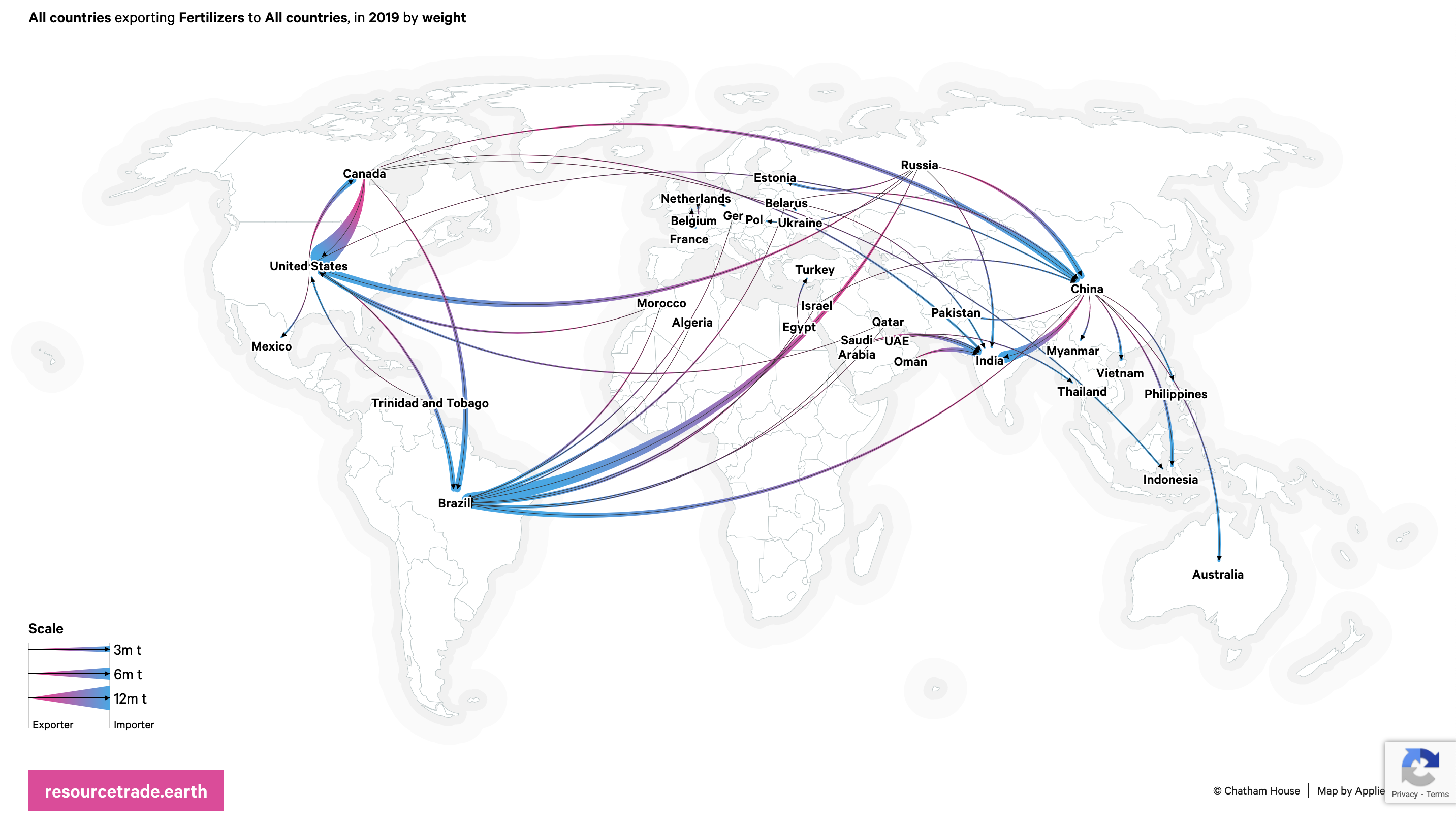
As fertiliser prices rose throughout the spring, the effects were felt across the agricultural sector. Food prices rose accordingly, with the FAO Food Price Index reaching its highest-ever peak in March.
This blew my mind🤯 Around HALF of the input costs of most staple foods are closely tied to energy costs...
— Dave Jones (@CoalFreeDave) June 15, 2022
(and i'm guessing very little of that as at 2022 is renewable energy...) #energytwitter https://t.co/TuQydVXKZ4 pic.twitter.com/AWtoTgrcyn
In April, Reuters reported that manure prices have spiked as well – up to twice the normal cost – with manure suppliers facing more demand than they could fill. The equipment needed to spread manure on fields was also on backorder in many places.
Even if the war were to end tomorrow, the ripple effects of Russia’s invasion of Ukraine will be felt for years to come. This is because farmers tend to buy their fertilisers and other inputs a year in advance. A report released by the US Department of Agriculture’s Foreign Agricultural Service in April noted:
“For agricultural producers around the world, high fertiliser and fuel prices are a major concern. Some producers will also face higher interest rates, further increasing production costs and potentially affecting planted acreage…Reduced fertiliser use threatens to lower future crop yields.”
Several scientists interviewed by Carbon Brief expressed their optimism about the current crisis as a vehicle for change. Ladha tells Carbon Brief:
“This is a crisis, but this crisis actually can give a very good opportunity…in many areas of the world, there is excess use of nitrogen – [a] misuse of nitrogen…We can use this crisis and turn it into an opportunity to improve nitrogen efficiency and also bring in other sources [of nitrogen] that can improve soil health.”
And Prater tells Carbon Brief:
“Ultimately, we’re going to have to change from the system we’re in now. Whether the reason is high prices of fertiliser or climate…The sooner we start that pivot, the better off we’re going to be in 10 years.”
However, in the midst of the war, some groups are seizing the opportunity to take the opposite approach, pushing back against sustainable farming initiatives, such as the EU’s Farm to Fork strategy.
In March, EurActiv wrote that French president Emmanuel Macron wanted French agriculture to focus on food security and “agricultural independence” over the sustainability goals laid out in the Farm to Fork strategy. EurActiv reported in May that Germany’s agricultural minister was lobbying for the relaxation of crop-rotation rules to allow farmers to grow more wheat. These calls have been met with resistance from civil society groups and environment-focused non-governmental organisations.
What are governments doing to regulate fertiliser use?
Addressing the G7 ministerial conference in June 2022, FAO director-general Qu Dongyu outlined five steps to address the threats to global food security, including to “ensure better and more efficient use of available fertilisers”. He continued:
“All countries should improve fertiliser efficiency to fit local farming systems…In the medium- and long-term there is a pressing need to invest in better use of chemical fertilisers along with manure, bio-fertilisers and other new products based on new technologies.”
Both national and international policies have been slow to address the issues presented by fertiliser use. The Glasgow Climate Pact, which emerged from the COP26 climate talks in November 2021, was “amazingly disappointing” with respect to non-CO2 greenhouse gases including nitrous oxide, Sutton says. Even the more noteworthy commitments, such as the Global Methane Pledge, fell short, he adds:
“This is something that could have been done at COP1, not COP26.”
In October 2019, the Colombo Declaration kicked off the UN Global Campaign on Sustainable Nitrogen Management, which called on countries to “develop and implement policies on sustainable nitrogen management” and established a nitrogen working group within the UN Environment Programme.
At the fifth session of the UN Environment Agency in early 2022, delegates discussed a draft resolution on sustainable nitrogen use (pdf), which was ultimately adopted on 2 March. The resolution notes the negative impacts of overuse of nutrients on species, ecosystems and climate change, and adds that reducing nitrogen waste “offer[s] the potential to save billions of US dollars annually”. The document encourages, but does not require, member states “to accelerate actions to significantly reduce nitrogen waste globally by 2030 and beyond through the improvement of sustainable nitrogen management”.
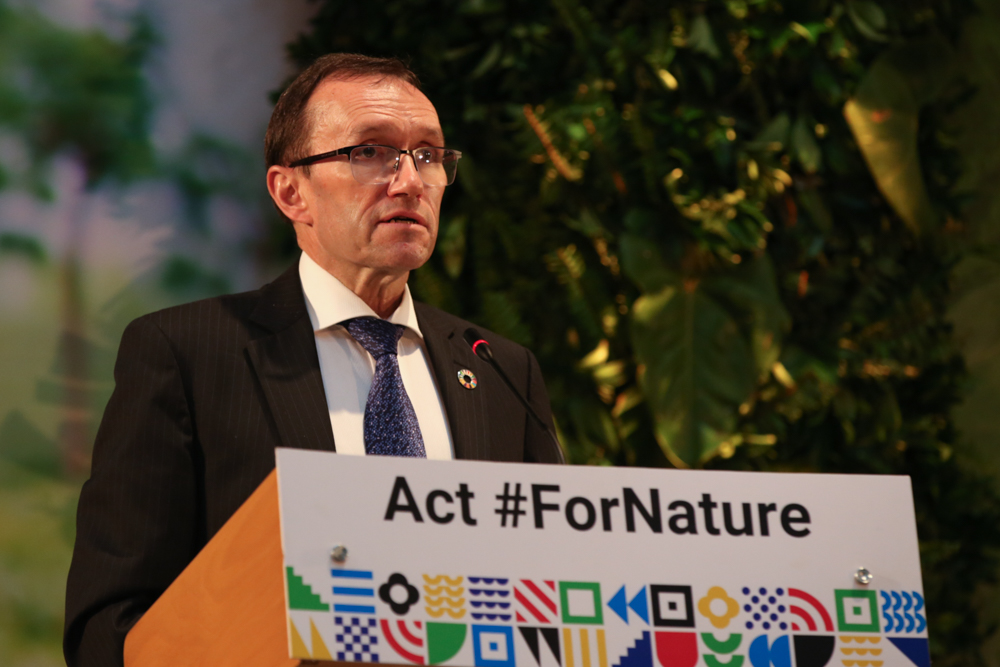
According to the Earth Negotiations Bulletin, Sri Lanka’s insistence on calling for ambition to halve nitrogen waste by 2030 received pushback from Argentina, Brazil, Canada, Japan and the US, with the US adding the language that extended the target to “2030 and beyond”.
Some nations have also begun to take measures to reduce nitrogen waste. The UK government launched a consultation in November 2020 “seeking views on reducing ammonia emissions from solid urea fertilisers used for growing plants and crops”. It noted a commitment to reduce ammonia emissions by 16% of 2005 levels by 2030.
Canada’s updated climate plan, announced in December 2020, includes a target of reducing the emissions related to fertiliser application by 30% below 2020 levels by 2030. It covers both direct and indirect application-related emissions, but not the manufacture of the fertiliser itself. A related discussion paper calls the target “ambitious, but achievable”.
In the south-eastern Indian state of Andhra Pradesh, some six million farmers are transitioning to a method of farming known as “zero-budget natural farming” (ZBNF), with the government’s support. ZBNF involves eliminating fertiliser and other chemical use in favour of regenerative and other sustainable approaches. The transition, which will affect 8m hectares of conventionally farmed agricultural land, is set to be completed by 2024.
In other parts of the world, however, governmental policies are still focused on increasing fertiliser use. Earlier this year, the government of Brazil released a national strategic plan for fertilisers aimed at reducing the country’s reliance on fertiliser imports by promoting investment in and expanding domestic fertiliser production. And the Africa Fertilizer Financing Mechanism, an initiative of the African Development Bank Group, seeks to boost agricultural productivity across the continent through promoting fertiliser use.
How can farming practices reduce fertiliser dependency?
As awareness of the problems associated with nitrogen fertiliser has grown, there has been increased interest in finding more sustainable uses while maintaining enough crop productivity to feed a continually growing world population.
“I don’t think it’s possible to substitute 100% of synthetic nitrogen,” Ladha tells Carbon Brief. But there are measures farmers can take to reduce fertiliser use – and to reduce their climate and environmental impact accordingly, he adds.
Some fertiliser companies have begun to explore “greener” methods of fertiliser production, including by powering the Haber-Bosch process using renewable energy sources. Other research focuses on finding alternative methods of ammonia synthesis.
Fertiliser giant Yara states that, by next year, it will be selling “fossil free, green fertilisers produced using renewable electricity instead of fossil fuels…essentially be made with water and air”. It claims these fertilisers will have a carbon footprint that is 80-90% lower than that of traditional synthetic fertilisers.
Nutrien, the world’s biggest fertiliser company, says it has the capacity to produce about 1m tonnes of “low-carbon” ammonia and that is committed to “invest[ing] in new technologies and pursu[ing] the transition to low-carbon fertilisers, including low-carbon and clean ammonia”.
However, producing fertiliser using green methods would only eliminate one dimension of the environmental impacts. Some portion of the applied fertiliser would still be converted into nitrous oxide and lost to the atmosphere. And overuse of green fertiliser would pose the same threat to waterways and soil health.
A 2021 analysis examined how different methods of green ammonia production could impact sustainability across the other planetary boundaries, such as biosphere diversity and freshwater use. It found that “alleviating the impact on climate change could critically exacerbate the impacts on other Earth-system processes”.
Organisations such as NCAT have established themselves as resources for farmers looking to transition away from synthetic fertilisers, but the process does not happen overnight. On NCAT’s website, it notes that the transition “can be accomplished strategically over three to five years”. This lag time, combined with the precarious nature of farming in general, means that convincing farmers to take the leap to organic or regenerative farming can be a hard sell, Prater says:
“Unfortunately, it gets to pretty dire straits before people are like, ‘alright, I guess it’s this or nothing’. Ultimately, we’d like to catch farmers before they get to those desperate situations, because that’s incredibly stressful and scary, and not really a good recipe for success.”
There are a range of practices that are promoted for reducing fertiliser use and building up healthy soils. At the foundation of many of them is “no-till” or “low-till” agriculture – minimally disturbing soils, rather than ploughing fields. No-till agriculture can improve soil water and organic matter retention and reduce soil erosion and nitrous oxide emissions.
“We don’t talk about sustainable agriculture in Brazil without no-till,” Martins tells Carbon Brief.
Another commonly touted practice is the use of cover crops – secondary crops that are planted after a harvest, rather than leaving a field fallow. The root systems created by cover crops can build up soil organic matter content – and using soya or other legumes can increase nitrogen content of the soils.
Cover crops also decrease soil erosion and can help suppress the growth of weeds. In some cases, cover crops are harvested and sold, or grazed by livestock; in other cases, the residue can be left on the ground to act as mulch or incorporated into the soil as “green manure”.
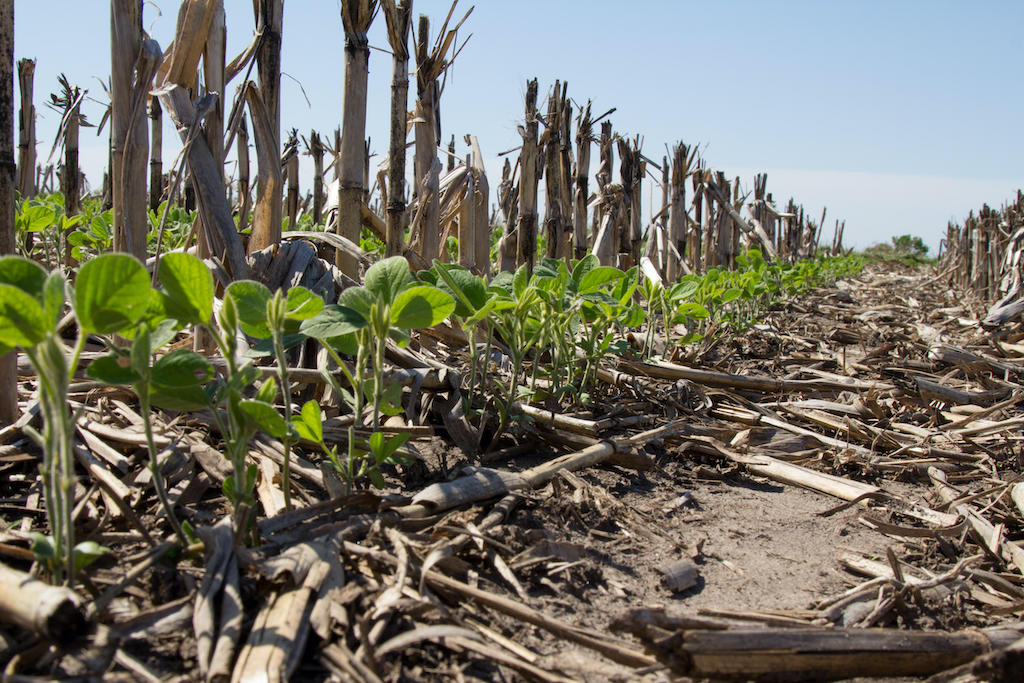
A meta-analysis published in May 2022 examined 41 research papers and showed that the use of cover crops reduces the amount of nitrate leached out of the soil by nearly 70% as compared to fields left to fallow. The reduction is modulated by a number of factors, including the species used as a cover crop, how much the soil is tilled and what type of crop is being grown in a specific field.
For livestock farmers, rotational grazing – where livestock are constantly moved between different small plots of land, rather than given free range across an entire property – is one way of reducing the need for fertilisers while improving soil health. If livestock are continuously grazing, they tend to return to their same, favourite spots over and over again, never allowing the plants to recover. But, if the animals are moved to a different part of the pasture, plants can regrow during this resting period and build more organic matter, Prater says:
“If you have healthier plants, they’re going to build healthier soils.”
Since moving from conventional, continuous grazing to the rotational method, Prater has seen increasing levels of soil organic matter and improved pasture health. “It’s much more lush,” she says. When it rains, she adds, much more water is held in the soils instead of running off into nearby ponds.
However, cover-cropping may not be feasible in all contexts. Ladha tells Carbon Brief:
“[In parts of Asia] cropping intensity is so high that farmers don’t have that free land available for two months. They harvest rice, they immediately have to plant wheat.”
When livestock and crop farmers work together in so-called “integrated systems”, they can both reap the benefits, Martins says. A 2021 paper that she co-authored found that re-integrating farming systems in the Rio de la Plata region of South America can provide not just ecosystem resilience, but economic resilience as well. The nutrient uptake increased and yields improved under the integrated systems across the study systems. Part of this, Martins tells Carbon Brief, is because traditional cropping systems in Brazil only make use of the soil for a few months a year.
“With the integrated crop-livestock system, what we propose is to use the soil the whole year.”
Coordination between farmers is often a barrier towards integration. Many farmers prefer the simplicity of specialisation, she adds, and crop farmers do not necessarily talk to livestock farmers. Government programmes can help promote more sustainable farming, but many of the policies put in place by previous administrations have been rolled back over the past several years, Martins says. She tells Carbon Brief:
“Even agroecology here in Brazil is not recognised as ‘real agriculture’. The ‘real agriculture’ for many people, and especially many people in politics and government, is agribusiness…The traditional knowledge of our people, of Indigenous people is a very low alternative.”
How can the world reduce fertiliser waste?
Given the emotions and vested interests connected to farming, it is not realistic to think that every farmer will change from conventional agriculture to a regenerative approach, Sutton says. But he would challenge farmers across the spectrum to do what they can to reduce the nitrogen wasted on their farms.
Even countries with low fertiliser use can still end up with relatively high proportions of nitrogen waste, as is the case across much of Africa, Sutton says. He tells Carbon Brief:
“There are such deep belief systems between one view of the world and another view of the world. I find it more pragmatic to say, wherever people are at, there’s something they can do to manage the system better.”
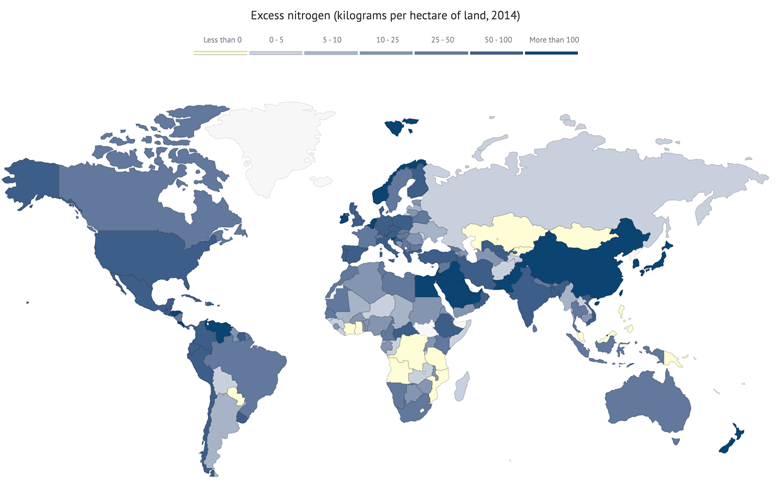
Beyond the climate and environment implications, reducing nitrogen loss just makes financial sense, Sutton adds:
“There’s a really strong economic case to say, ‘let’s do better’.”
One of the keys to reducing nutrient loss is being more precise about fertiliser application – making sure that fertiliser is being applied at the right time, in the right quantity and in the right manner in order to reduce loss.
In his work, Ladha has developed simple tools such as plant colour charts to help farmers make better decisions about when to apply fertiliser – and when not to. Using slow-release fertilisers, which continuously feed plants nutrients over a longer period of time, can help ensure that fewer nutrients are wasted.
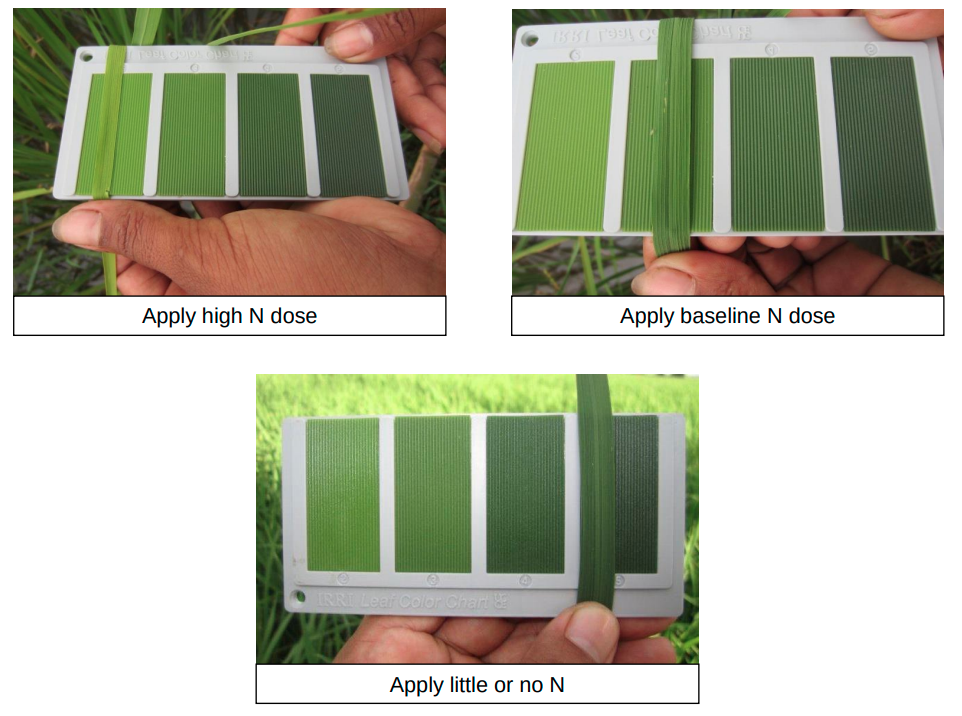
Another key to reducing waste is moving to a more circular nutrient economy, where wasted nutrients are recycled into a usable form once again. This is especially important for phosphorus given its relative scarcity, Sutton says.
Vaneeckhaute is one scientist working on such problems. Her research focuses on recovering nutrients from waste streams, such as manure, food waste or sewage sludge. When wastewater is treated, it is typically aerated to transform reactive nitrogen species into nitrogen gas. In addition to being energy-intensive, this process essentially undoes the work that was performed by the Haber-Bosch process.
Instead, Vaneeckhaute uses anaerobic digesters to break down the waste into solid and liquid fractions. The solid fraction looks just like compost, she says, and can be treated further and used as an organic fertiliser. The liquid fraction can be treated to extract compounds into a mineral fertiliser that can be used in place of synthetic versions.
In both field and greenhouse trials, the performance of these recovered products is “equal [to] or better” than that of conventional mineral fertilisers, Vaneeckhaute says. But the widespread use of waste-derived products can face regulatory barriers. For example, previous EU regulations governing fertiliser use focused solely on inorganic fertilisers. As a result, organic and waste-derived fertilisers were largely restricted to domestic sale and use.
On the farm, some simple measures can be taken on the farm to limit direct emissions from fertilisers, such as covering manure piles to minimise the release of ammonia vapours. Certain compounds, added to conventional fertilisers, can reduce the amount of ammonia or nitrous oxide produced by soil microbes – and thereby increase the amount of nitrogen that is taken up by crops.
However, governmental and international action is going to be key to addressing the nitrogen problem. “If you remove the subsidy on fertilisers, there are huge potentials,” Ladha says. Ultimately, farmers will need incentives – and support – to make the transition to a more sustainable type of agriculture, Prater says. She tells Carbon Brief:
“When you're talking about soil and our natural resources, you really have to think long term, multiple generations ahead. My grandfather-in-law is 88, and my son is seven. I want my son to be able to farm – if he chooses – on land that's better than it was when my grandfather started. We've got to create systems that value that, and that encourage that kind of land management.”
-
Q&A: What does the world’s reliance on fertilisers mean for climate change?


